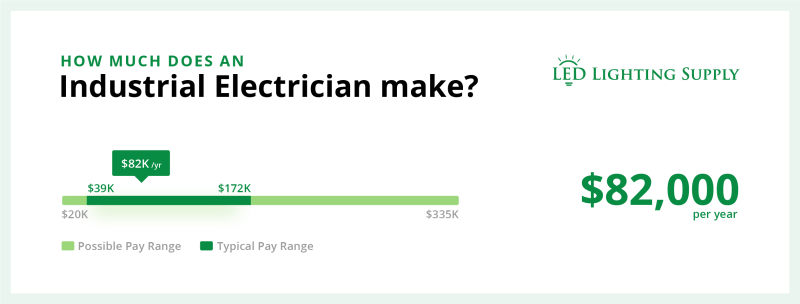The Complete Guide to Electrician Salaries by Specialty
Electrician jobs are in demand across the United States. They play an important role because electrical systems are vital to the management of many things. They include lighting systems, communication systems, and machinery. These systems are essential to the operations of homes, roadways, factories, offices, and public areas. Professional electricians need in-depth knowledge and training throughout their careers.
Because of the demand for their skills, they can earn a generous salary. But exactly how much are they paid? What are the different types of electricians? Is there a difference in the salaries that they earn? We’ll explore the answers to these questions for specific subcategories of electricians in this article.
What is an Electrician?
Electricians maintain, repair, and install electrical systems. Their specific job duties vary, depending on their company, industry, and location. General responsibilities may include:
- Install, maintain, troubleshoot, and upgrade electrical systems
- Inspect electrical service panels or fuse boxes for safety issues
- Identify the source of power outages
There are two general types of electricians:
- Wireman – A Wireman works indoors in places such as homes, offices, and other structures. They work with lower voltages typically associated with inside buildings. They install, maintain, and repair electrical systems and commercial lighting / industrial lighting for buildings and facilities.
- Lineman – Linemen work outdoors as powerline technicians, highway systems electricians, and telecommunications line installers.
There are many specialized types of electricians within these two categories. For wiremen, they include Residential, Commercial, and Industrial Electricians.

What’s the Difference Between a Residential, Commercial and Industrial Electrician?
1. Residential Electricians
- Residential Electricians are the most common type of electricians.
- They install, maintain, troubleshoot, and upgrade electrical systems within a home. This includes houses, apartments, and condominiums.
- They usually work with voltage systems between 120 volts and 240 volts.
- Examples of electrical systems that they work on are security systems, appliances, lighting, heating, and cooling systems.
2. Commercial Electricians
- Commercial Electricians install, repair, and maintain electrical systems in commercial buildings. This includes offices, sports fields, parking lots, and schools.
- They usually work with extra-high-voltage systems. These systems exceed 240 volts for large commercial buildings.
- Examples of electrical systems that they work on are security systems, electronic systems, power systems, natural gas delivery systems, and heating and cooling systems.
- Along with basic electrical skills, Commercial Electricians also need to know the principles of hydraulics and pneumatics.
3. Industrial Electricians
- Industrial Electricians install, maintain, and repair electrical equipment in industrial buildings. This includes manufacturing facilities, warehouses, factories, power plants, processing plants, and mines.
- The electrical work needed in industrial buildings is more complex than in commercial or residential settings. Industrial Electricians need to complete some years of apprenticeship job training. They must show a mastery of skills in electrical wiring, electricity fundamentals, electrical controls, blueprint reading, and electrical code.
- They usually report to maintenance supervisors or facility managers. This requires teamwork and communication skills. Examples of electrical systems that they work on are manufacturing systems, complex machinery, security systems, and lighting systems.
What’s Your Electrician Career Path?
How do you become an electrician? Usually, it begins with on-the-job training and possibly time spent at a trade school. If you are looking to work at a larger firm, it may take more than just knowing somebody. You will want to have a professional resume to show you are serious about the opportunity. Either way, you must complete three important stages to advance your career. Those stages are Apprentice, Journeyman, and Master Electrician.
Step 1 – You Start as an Apprentice
- A high school diploma (or equivalent) is required to apply to an electrician training program, in most states.
- You must then complete the associated coursework before applying for an apprenticeship program under a licensed electrician.
Step 2 – You then become a Journeyman
- Once an apprenticeship program is completed, you can take a Journeyman license exam. Those who pass the exam will then receive their license from the associated licensing group at the local, state, or federal level.
- A licensed Journeyman can work without supervision. They are also qualified to train new apprentices.
Step 3 – You’re a Master Electrician
- This is the top level of electrical certification.
- The primary standard for most states is around 4,000 hours of electric work as a Journeyman. Then you need to take a licensing exam to show in-depth knowledge of the National Electrical Code.
- Master Electricians work on the most complex commercial and industrial projects. They also have the experience to train Journeymen electricians.
What’s an Independent Electrical Contractor?
- An Independent Contractor must have the skills to operate a business along with the required electrical skills.
- Some of the most profitable work is reserved for electricians who go on to become Independent Contractors.
Wages by Category
How Do Union Versus Non-union Salaries Compare?
Will membership in an electrician’s union influence the amount of your salary? What are the differences between them?Union wages are usually higher than non-union wages, even after deducting union dues. Unions can get higher wages for their employees thanks to collective bargaining arrangements. Union electricians usually have better benefits, which include health care and pensions. The largest electrical workers union is the International Brotherhood of Electrical Workers (IBEW). In rural areas, non-union or independent contractors may have more available work. The U. S Department of Labor determines what are “prevailing wages”. Prevailing wages are based on many factors. They include types of labor, type of project performed, and the location of the project. Around half of all states have adopted prevailing wages. Its goal is to even the chances among union and non-union workers. With no prevailing wages, non-union contractors could submit a lower bid for a project. They might pay employees low wages or reduce costs in crucial areas such as worker safety as a result. An electrician working on a federal project is paid the prevailing wage determined by the U. S. Department of Labor. This is done irrespective of whether you work for a union or non-union employer. States that have prevailing wages use standards for which projects qualify.
What are Residential Electrician Salaries?
What is the potential salary for a Residential Electrician? According to our research, their median total pay in the U. S. is roughly $68,000. Understand that this number can vary depending on experience level and geographic location. Residential Electricians earn less than the median for Commercial Electricians or Industrial Electricians. This is because the electrical systems that they work on are not as complex and require less skills and experience.

What are Commercial Electrician Salaries?
What is the potential salary for a Commercial Electrician? Our research tells us that their median total pay in the U. S. is about $72,000. Again, recognize that this number can vary depending on experience level and geographic location. Commercial Electricians earn more than the median for Residential Electricians. Why is this the case? It’s because the electrical systems that they work with are on a larger scale than in homes or other residences. However, they earn less than the median for Industrial Electricians.

What are Industrial Electrician Salaries?
Finally, our research found that Industrial Electricians earn a larger median salary than their residential and commercial counterparts. The median total pay in the U. S. for an Industrial Electrician is roughly $82,500. Once again, keep in mind that this number can vary depending on experience level and geographic location. Why do they earn more? It’s because the electrical systems that they work on are very complex. These types of electricians need more skills and experience than the others.

What are Construction Electrician Salaries?
What about electricians that work with new construction? What are the differences in their job descriptions compared to the others? How much do they earn compared to the other types of electricians mentioned above?One important difference is that their job specializations are more concentrated in the lineman (outdoor) area. This means that they are more likely to work at places such as construction sites or roadways. This requires them to work on things like power lines, transformers, or electrical substations. We found that the median total pay in the U. S. for a Construction Electrician is roughly $70,500. They have a median pay somewhere between Residential and Commercial Electricians.

What are Electrical Contractor Salaries?
Want to go into the electrical business for yourself? If so, it can be very demanding but quite lucrative. The median total (base + additional) pay in the U. S. for an Electrical Contractor is $80,848. Other than Industrial Electricians, Electrical Contractors have a greater median pay than the other types of electricians discussed in this article.

Commercial and Industrial Electrician Salaries by State (2022)
- Alaska: $80,319
- North Dakota: $70,392
- Oregon: $69,132
- Minnesota: $67,682
- Connecticut: $65,305
- Washington: $75,292
- Vermont: $73,461
- New Jersey: $61,894
- Massachusetts: $62,565
- New York: $60,700
- California: $60,300
- Rhode Island: $59,862
- Hawaii: $59,359
- Montana: $59,070
- New Hampshire: $58,627
- Wyoming: $58,426
- Maryland: $55,984
- Maine: $55,955
- Pennsylvania: $53,890
- Wisconsin: $53,700
- Michigan: $52,348
- Ohio: $51,354
- Idaho: $51,549
- Delaware: $51,019
- Illinois: $50,266
- Indiana: $48,994
- Missouri: $49,378
- Nebraska: $49,044
- Nevada: $49,875
- West Virginia: $46,554
- Colorado: $46,625
- Utah: $45,716
- Virginia: $45,348
- Kentucky: $44,655
- South Dakota: $44,933
- Georgia: $43,165
- Iowa: $42,856
- Arizona: $42,420
- Louisiana: $40,241
- North Carolina: $40,401
- New Mexico: $39,782
- Texas: $39,463
- Tennessee: $39,442
- South Carolina: $38,441
- Kansas: $38,000
- Alabama: $37,195
- Oklahoma: $36,788
- Mississippi: $36,655
- Arkansas: $36,520
- Florida: $35,056
